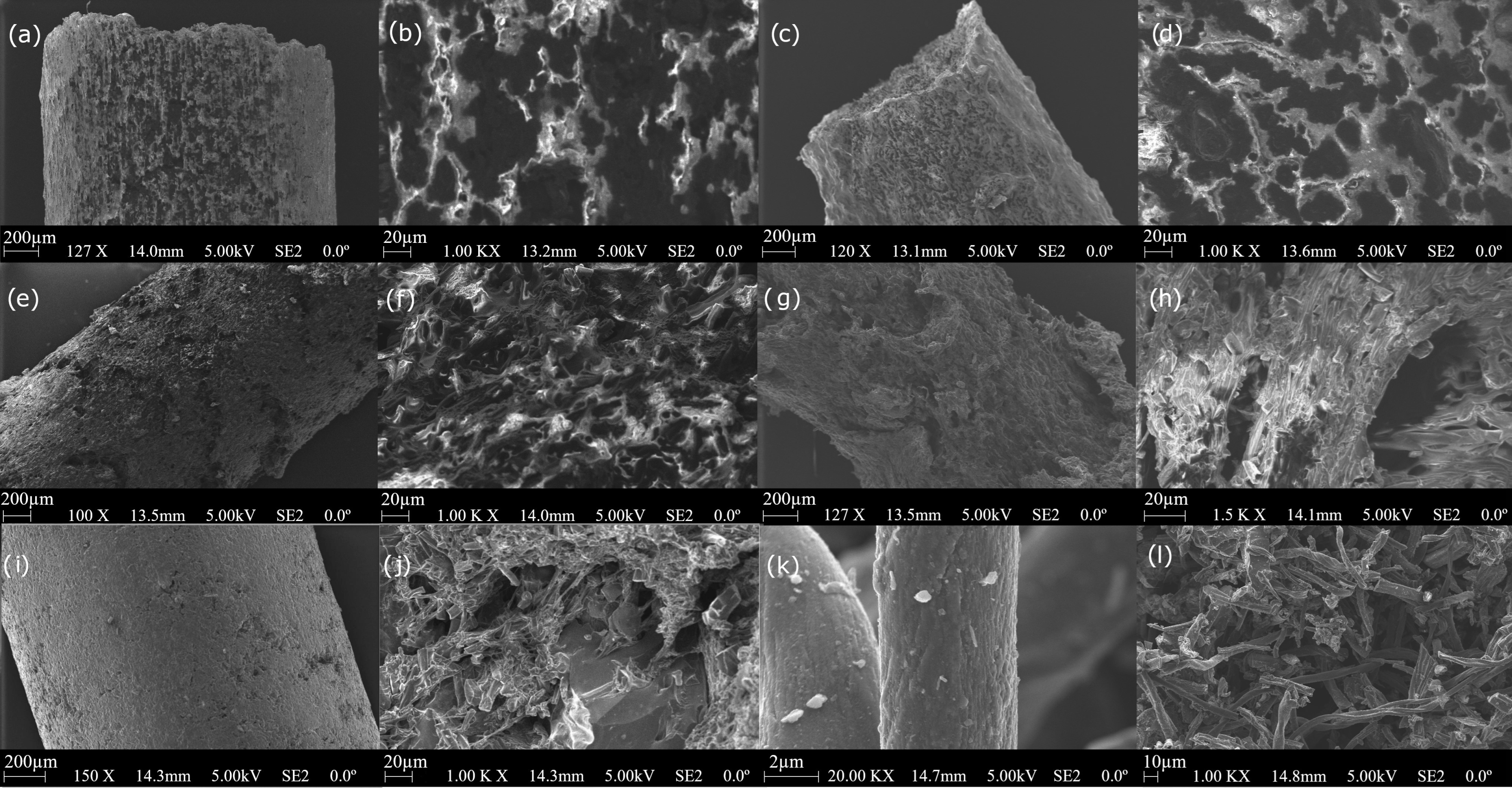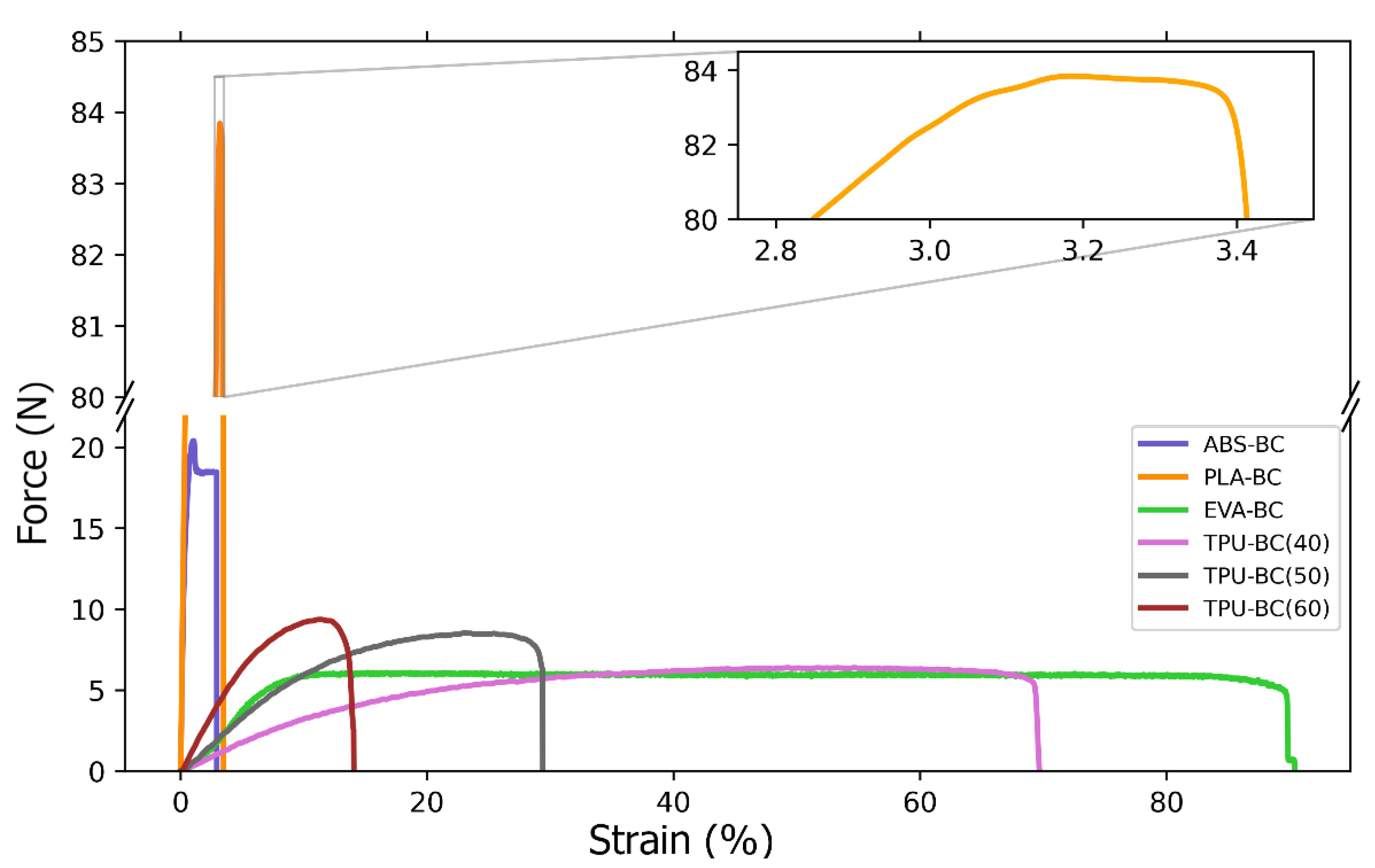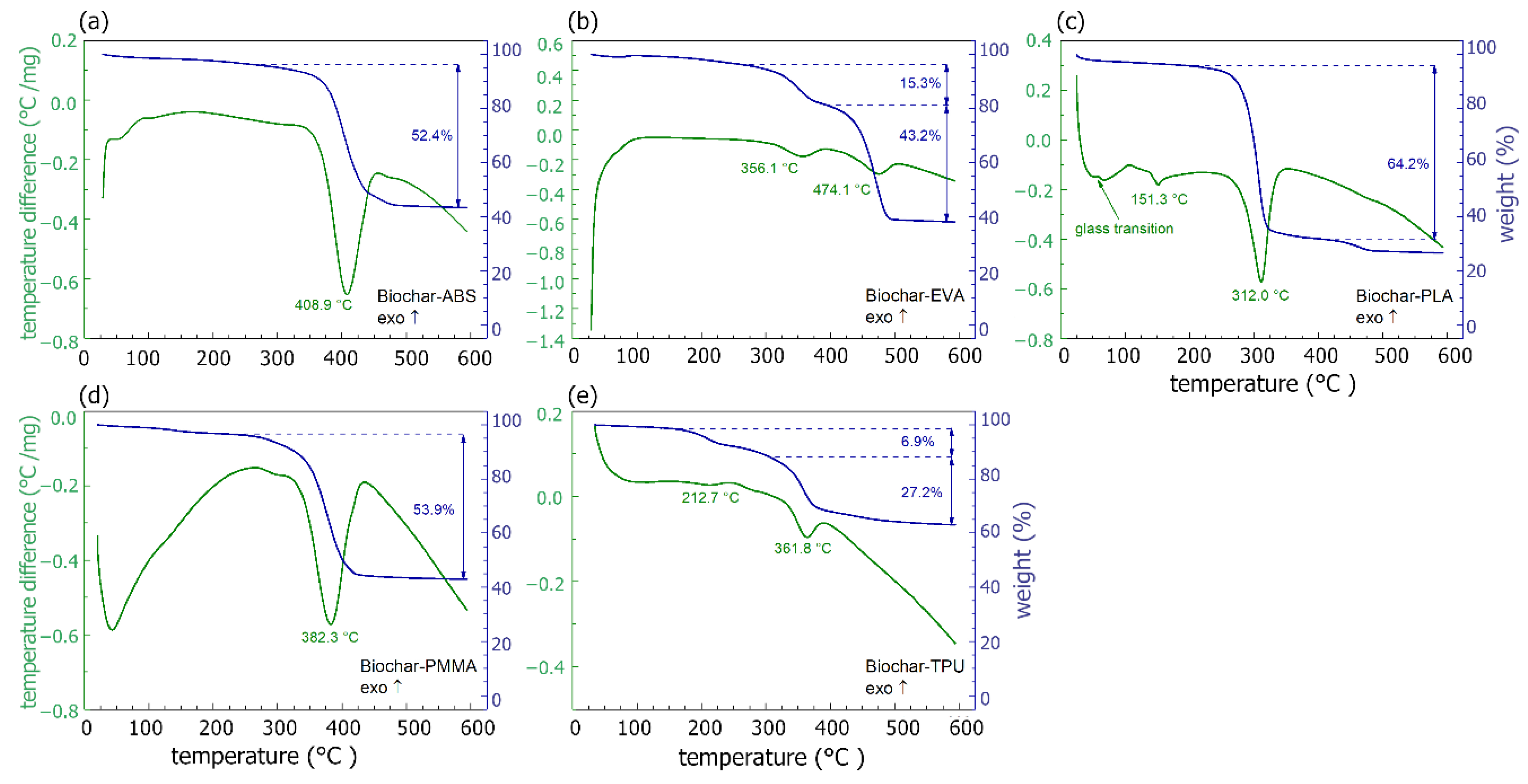Innovative Biochar-Based Composite Fibres from Recycled Material
Abstract
:1. Introduction
2. Materials and Methods
2.1. Materials
Composite Preparation
2.2. Methods
3. Results and Discussion
3.1. SEM Analysis
3.2. Electrical Results
3.3. Mechanical Results
3.4. Thermal and Thermogravimetrical Results
3.5. XRD Measurement Results
4. Conclusions
Author Contributions
Funding
Institutional Review Board Statement
Informed Consent Statement
Data Availability Statement
Conflicts of Interest
References
- Wang, B.; Zhang, W.; Zhang, W.; Mujumdar, A.S.; Huang, L. Progress in Drying Technology for Nanomaterials. Dry. Technol. 2005, 23, 7–32. [Google Scholar] [CrossRef]
- Rao, C.N.R.; Cheetham, A.K. Science and Technology of Nanomaterials: Current Status and Future Prospects. J. Mater. Chem. 2001, 11, 2887–2894. [Google Scholar] [CrossRef]
- Baughman, R.H.; Zakhidov, A.A.; de Heer, W.A. Carbon Nanotubes—The Route toward Applications. Science 2002, 297, 787–792. [Google Scholar] [CrossRef] [PubMed] [Green Version]
- Guldi, D.; Prato, M. Excited-State Properties of C60 Fullerene Derivatives. Acc. Chem. Res. 2000, 33, 695–703. [Google Scholar] [CrossRef] [PubMed]
- Innocenzi, P.; Brusatin, G. Fullerene-Based Organic−Inorganic Nanocomposites and Their Applications. Chem. Mater. 2001, 13, 3126–3139. [Google Scholar] [CrossRef]
- Science. Graphene: Status and Prospects. Available online: https://science.sciencemag.org/content/324/5934/1530 (accessed on 14 April 2020).
- Tang, Z.K.; Zhang, L.; Wang, N.; Zhang, X.X.; Wen, G.H.; Li, G.D.; Wang, J.N.; Chan, C.T.; Sheng, P. Superconductivity in 4 Angstrom Single-Walled Carbon Nanotubes. Science 2001, 292, 2462–2465. [Google Scholar] [CrossRef]
- Li, H.; Kang, Z.; Liu, Y.; Lee, S.-T. Carbon Nanodots: Synthesis, Properties and Applications. J. Mater. Chem. 2012, 22, 24230–24253. [Google Scholar] [CrossRef]
- Zhao, Q.; Lin, Y.; Han, N.; Li, X.; Geng, H.; Wang, X.; Cui, Y.; Wang, S. Mesoporous Carbon Nanomaterials in Drug Delivery and Biomedical Application. Drug Deliv. 2017, 24, 94–107. [Google Scholar] [CrossRef]
- Tripathi, P.K.; Gan, L.; Liu, M.; Rao, N.N. Mesoporous Carbon Nanomaterials as Environmental Adsorbents. J. Nanosci. Nanotechnol. 2014, 14, 1823–1837. [Google Scholar] [CrossRef]
- Vozniakovskii, A.; Kidalov, S.; Vozniakovskii, A.; Karmanov, A.; Kocheva, L.; Rachkova, N. Carbon Nanomaterials Based on Plant Biopolymers as Radionuclides Sorbent. Fuller. Nanotub. Carbon Nanostructures 2020, 28, 238–241. [Google Scholar] [CrossRef]
- Kinloch, I.A.; Suhr, J.; Lou, J.; Young, R.J.; Ajayan, P.M. Composites with Carbon Nanotubes and Graphene: An Outlook. Science 2018, 362, 547–553. [Google Scholar] [CrossRef] [PubMed] [Green Version]
- Wang, W.; Zhu, Y.; Liao, S.; Li, J. Carbon Nanotubes Reinforced Composites for Biomedical Applications. BioMed Res. Int. 2014, 2014, e518609. [Google Scholar] [CrossRef] [PubMed]
- Wu, X.; Mu, F.; Zhao, H. Recent Progress in the Synthesis of Graphene/CNT Composites and the Energy-Related Applications. J. Mater. Sci. Technol. 2020, 55, 16–34. [Google Scholar] [CrossRef]
- Bartoli, M.; Giorcelli, M.; Jagdale, P.; Rovere, M.; Tagliaferro, A. A Review of Non-Soil Biochar Applications. Materials 2020, 13, 261. [Google Scholar] [CrossRef] [Green Version]
- Cha, J.; Park, S.; Jung, S.-C.; Ryu, C.; Jeon, J.-K.; Shin, M.-C.; Park, Y.-K. Production and Utilization of Biochar: A Review. J. Ind. Eng. Chem. 2016, 40, 1–15. [Google Scholar] [CrossRef]
- Savi, P.; Josè, S.P.; Khan, A.A.; Giorcelli, M.; Tagliaferro, A. Biochar and Carbon Nanotubes as Fillers in Polymers: A Comparison. In Proceedings of the 2017 IEEE MTT-S International Microwave Workshop Series on Advanced Materials and Processes for RF and THz Applications (IMWS-AMP), Pavia, Italy, 20–22 September 2017; pp. 1–3. [Google Scholar]
- Khan, A.; Savi, P.; Quaranta, S.; Rovere, M.; Giorcelli, M.; Tagliaferro, A.; Rosso, C.; Jia, C.Q. Low-Cost Carbon Fillers to Improve Mechanical Properties and Conductivity of Epoxy Composites. Polymers 2017, 9, 642. [Google Scholar] [CrossRef] [Green Version]
- Giorcelli, M.; Khan, A.A.; Tagliaferro, A.; Savi, P.; Berruti, F. Microwave Characterization of Polymer Composite Based on Biochar: A Comparison of Composite Behaviour for Biochar and MWCNTs. In Proceedings of the 2016 IEEE International Nanoelectronics Conference (INEC), Chengdu, China, 9–11 May 2016; pp. 1–2. [Google Scholar]
- Lepak-Kuc, S.; Boncel, S.; Szybowicz, M.; Nowicka, A.B.; Jozwik, I.; Orlinski, K.; Gizewski, T.; Koziol, K.; Jakubowska, M.; Lekawa-Raus, A. The Operational Window of Carbon Nanotube Electrical Wires Treated with Strong Acids and Oxidants. Sci. Rep. 2018, 8, 1–12. [Google Scholar] [CrossRef]
- Lepak-Kuc, S.; Milowska, K.Z.; Boncel, S.; Szybowicz, M.; Dychalska, A.; Jozwik, I.; Koziol, K.K.; Jakubowska, M.; Lekawa-Raus, A. Highly Conductive Doped Hybrid Carbon Nanotube–Graphene Wires. ACS Appl. Mater. Interfaces 2019, 11, 33207–33220. [Google Scholar] [CrossRef]
- Lekawa-Raus, A.; Patmore, J.; Kurzepa, L.; Bulmer, J.; Koziol, K. Electrical Properties of Carbon Nanotube Based Fibers and Their Future Use in Electrical Wiring. Adv. Funct. Mater. 2014, 24, 3661–3682. [Google Scholar] [CrossRef]
- Lepak-Kuc, S.; Podsiadły, B.; Skalski, A.; Janczak, D.; Jakubowska, M.; Lekawa-Raus, A. Highly Conductive Carbon Nanotube-Thermoplastic Polyurethane Nanocomposite for Smart Clothing Applications and Beyond. Nanomaterials 2019, 9, 1287. [Google Scholar] [CrossRef] [Green Version]
- Noori, A.; Bartoli, M.; Frache, A.; Piatti, E.; Giorcelli, M.; Tagliaferro, A. Development of Pressure-Responsive PolyPropylene and Biochar-Based Materials. Micromachines 2020, 11, 339. [Google Scholar] [CrossRef] [Green Version]
- Bartoli, M.; Rosso, C.; Giorcelli, M.; Rovere, M.; Jagdale, P.; Tagliaferro, A.; Chae, M.; Bressler, D.C. Effect of Incorporation of Microstructured Carbonized Cellulose on Surface and Mechanical Properties of Epoxy Composites. J. Appl. Polym. Sci. 2020, 137, 48896. [Google Scholar] [CrossRef]
- Thermal Analysis of Polylactic Acid, TA no. 81 (2007.9), Hitachi High-Tech Science Corporation. Available online: https://www.hitachi-hightech.com/file/global/pdf/products/science/appli/ana/thermal/application_TA_081e.pdf (accessed on 16 December 2020).
- Quality Control of Polymers by Means of DSC—Thermal Behavior of Thermoplastic Polyurethane, Netsch. Available online: https://www.netzsch-thermal-analysis.com/en/materials-applications/polymers/quality-control-of-polymers-by-means-of-dsc-thermal-behavior-of-thermoplastic-polyurethane/ (accessed on 16 December 2020).
- Analysis of Ethylene Vinyl Acetate (EVA) (TGA-FT-IR), Netsch. Available online: https://www.netzsch-thermal-analysis.com/pl/materialy-zastosowanie/materialy-polimerowe/analysis-of-ethylene-vinyl-acetate-eva-tga-ft-ir/ (accessed on 16 December 2020).
- Ahamad, A.; Patil, C.B.; Mahulikar, P.P.; Hundiwale, D.G.; Gite, V.V. Studies on the Flame Retardant, Mechanical and Thermal Properties of Ternary Magnesium Hydroxide/Clay/EVA Nanocomposites. J. Elastomers Plast. 2012, 44, 251–261. [Google Scholar] [CrossRef]
- Kanbur, Y.; Tayfun, U. Investigating Mechanical, Thermal, and Flammability Properties of Thermoplastic Polyurethane/Carbon Nanotube Composites. J. Thermoplast. Compos. Mater. 2018, 31, 1661–1675. [Google Scholar] [CrossRef]
- Mofokeng, J.; Luyt, A.; Tábi, T.; Kovacs, J. Comparison of Injection Moulded, Natural Fibre Reinforced Composites with PP and PLA as Matrices. J. Thermoplast. Compos. Mater. 2012, 25, 927–948. [Google Scholar] [CrossRef]
- Abdulrazzak, F.H.; Alkiam, F.A.; Hussein, F.H. Behavior of X-Ray Analysis of Carbon Nanotubes. In Perspective of Carbon Nanotubes; IntechOpen: London, UK, 2019; ISBN 978-1-78984-402-3. [Google Scholar]
- Lepak-Kuc, S.; Taborowska, P.; Tran, T.Q.; Duong, H.M.; Gizewski, T.; Jakubowska, M.; Patmore, J.; Lekawa-Raus, A. Washable, Colored and Textured, Carbon Nanotube Textile Yarns. Carbon 2021, 172, 334–344. [Google Scholar] [CrossRef]
- Fu, K.; Yao, Y.; Dai, J.; Hu, L. Progress in 3D Printing of Carbon Materials for Energy-Related Applications. Adv. Mater. 2017, 29, 1603486. [Google Scholar] [CrossRef]
- Gonçalves, J.; Lima, P.; Krause, B.; Pötschke, P.; Lafont, U.; Gomes, J.R.; Abreu, C.S.; Paiva, M.C.; Covas, J.A. Electrically Conductive Polyetheretherketone Nanocomposite Filaments: From Production to Fused Deposition Modeling. Polymers 2018, 10, 925. [Google Scholar] [CrossRef] [PubMed] [Green Version]
- Dul, S.; Fambri, L.; Pegoretti, A. Filaments Production and Fused Deposition Modelling of ABS/Carbon Nanotubes Composites. Nanomaterials 2018, 8, 49. [Google Scholar] [CrossRef] [Green Version]
- Flowers, P.F.; Reyes, C.; Ye, S.; Kim, M.J.; Wiley, B.J. 3D Printing Electronic Components and Circuits with Conductive Thermoplastic Filament. Addit. Manuf. 2017, 18, 156–163. [Google Scholar] [CrossRef]
- Kim, K.; Park, J.; Suh, J.; Kim, M.; Jeong, Y.; Park, I. 3D Printing of Multiaxial Force Sensors Using Carbon Nanotube (CNT)/Thermoplastic Polyurethane (TPU) Filaments. Sens. Actuators Phys. 2017, 263, 493–500. [Google Scholar] [CrossRef]




| Polymer | Biochar Content (wt.%) | Average Absolute Conductivity (S/m) | Average Specific Conductivity (S m2/kg) |
|---|---|---|---|
| TPU | 40 | 3.14 × 10−2 | 1.99 × 10−5 |
| TPU | 50 | 5.17 × 10−1 | 3.39 × 10−4 |
| TPU | 60 | 11.9 | 7.44 × 10−3 |
| ABS | 50 | 7.73 × 10−2 | 5.3 × 10−5 |
| EVA | 50 | 2.01 × 10−1 | 1.44 × 10−4 |
| PLA | 50 | 1.03 × 10−2 | 8.49 × 10−6 |
| PMMA | 50 | 1.70 | 1.36 × 10−3 |
| Polymer | Biochar Content (wt.%) | Maximal Elongation of the Sample (%) | Ultimate Tensile Strength (MPa) |
|---|---|---|---|
| TPU | 40 | 70% | 3.28 |
| TPU | 50 | 29% | 4.81 |
| TPU | 60 | 14% | 5.10 |
| ABS | 50 | 3% | 11.89 |
| EVA | 50 | 90% | 3.11 |
| PLA | 50 | 3% | 47.56 |
Publisher’s Note: MDPI stays neutral with regard to jurisdictional claims in published maps and institutional affiliations. |
© 2021 by the authors. Licensee MDPI, Basel, Switzerland. This article is an open access article distributed under the terms and conditions of the Creative Commons Attribution (CC BY) license (https://creativecommons.org/licenses/by/4.0/).
Share and Cite
Lepak-Kuc, S.; Kiciński, M.; Michalski, P.P.; Pavlov, K.; Giorcelli, M.; Bartoli, M.; Jakubowska, M. Innovative Biochar-Based Composite Fibres from Recycled Material. Materials 2021, 14, 5304. https://doi.org/10.3390/ma14185304
Lepak-Kuc S, Kiciński M, Michalski PP, Pavlov K, Giorcelli M, Bartoli M, Jakubowska M. Innovative Biochar-Based Composite Fibres from Recycled Material. Materials. 2021; 14(18):5304. https://doi.org/10.3390/ma14185304
Chicago/Turabian StyleLepak-Kuc, Sandra, Mateusz Kiciński, Przemyslaw P. Michalski, Krystian Pavlov, Mauro Giorcelli, Mattia Bartoli, and Malgorzata Jakubowska. 2021. "Innovative Biochar-Based Composite Fibres from Recycled Material" Materials 14, no. 18: 5304. https://doi.org/10.3390/ma14185304
APA StyleLepak-Kuc, S., Kiciński, M., Michalski, P. P., Pavlov, K., Giorcelli, M., Bartoli, M., & Jakubowska, M. (2021). Innovative Biochar-Based Composite Fibres from Recycled Material. Materials, 14(18), 5304. https://doi.org/10.3390/ma14185304









